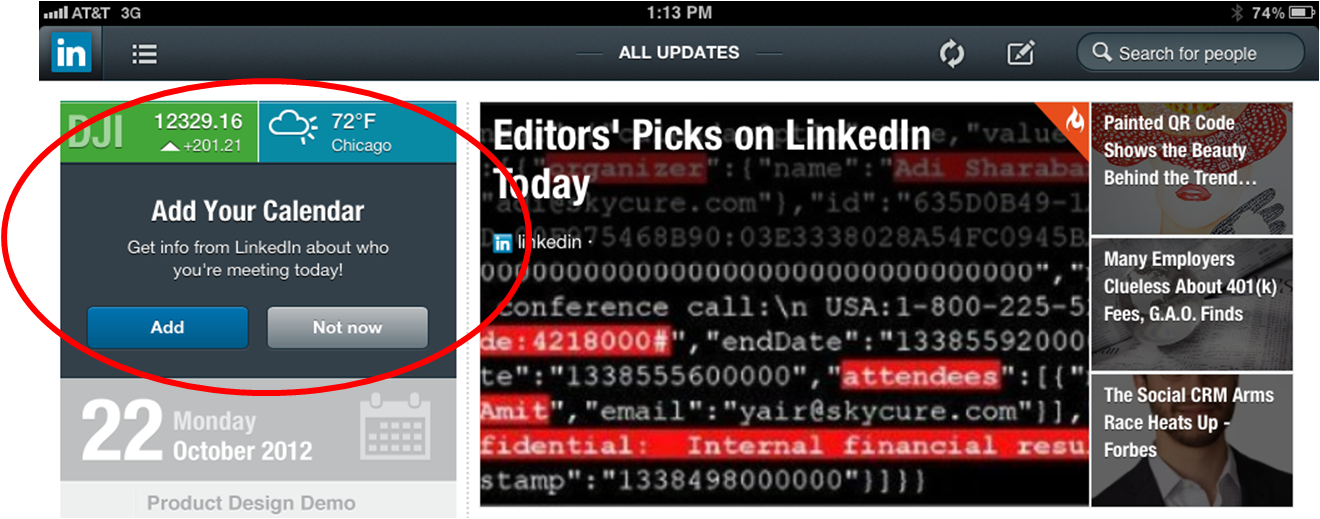The ‘Safest’ Social Network? LinkedIn’s App Betrays Business Users' Confidence
/ TweetI read with horror this morning’s news that LinkedIn’s iPhone and iPad apps have been collecting details about meeting locations, participants, dial-in information, passwords, related notes and meeting attachments from those who opted into the feature. Read more in these posts and comments: LinkedIn’s Leaky Mobile App Has Access to Your Meeting Notes and LinkedIn’s iOS app collects and transmits names, emails and notes from your calendar, in plain text.
In response, a LinkedIn blog post at some point today commented on its mobile calendar feature and said, “We will no longer send data from the meeting notes section of your calendar event,” a change made to Android and submitted to Apple for the iOS devices.
Learning Social On LinkedIn
To this industry whose marketers desperately want to explore contemporary means of communicating but operate within narrow guardrails, this is a blow. Across the board, asset management firms had come to think of LinkedIn as the "safest" social network. From the nature of the connections to the focus of the features and the tenor of the comments, LinkedIn had successfully established itself as all-business.
This held massive appeal to mutual fund and exchange-traded fund (ETF) companies put off by Facebook’s business/personal free-for-all and Twitter’s open forum. Many firms have preferred to “learn” on LinkedIn where they believed the risks were lower.
The first, measured step in learning? To establish an account, with firm approval, and to begin to see how social media works.
Because LinkedIn is included among the block of social sites blocked at many workplaces, asset management marketers were among the millions of business people who accessed LinkedIn via its iPad, made much more appealing in its late April release. This is the release that included the synchronization between the LinkedIn account and the Google Calendar or Exchange calendar on the device (also available on the iPhone and Android). You can see the promotion of the feature in the screenshot below from the LinkedIn app on my iPad. Clicking on Add gets it done, absolutely no explanation is provided.

But today’s news delivered a gotcha that strikes fear in the heart of every risk-averse, social media-skeptical manager at every asset management firm. It should. The LinkedIn app user who agreed to link his or her work calendar to his LinkedIn account unknowingly exposed business documents to LinkedIn, which has no business purpose in collecting them.
My guess is that few if any asset management communications were compromised because, I’m guessing, IT at most firms blocked the sync. The point is that it might have happened and nobody knew it.
Advisors At Risk?
But, what about everybody else, starting with independent financial advisors who have embraced LinkedIn, rely on Google apps including Gmail and may have jumped at the added convenience of the calendar sync? Advisors who set up meetings with LinkedIn contacts may have inadvertently leaked confidential documents attached to their meeting invitations, running afoul of regulations.
And this while LinkedIn has said that financial advisors are their fastest-growing segment.
This episode makes my blood boil but probably not as hot as the good people at LinkedIn who have a fire to put out. LinkedIn’s initial response today was tantamount to CYA. The New York Times quoted spokeswoman Julie Inouye as saying: “Calendar sync feature is a clear ‘opt-in’ experience” that syncs only when the LinkedIn app is open and that members could opt out of the calendar feature at any point.”
Later, right-minded businesspeople evidently recognized that you just can’t do this to your customers and then hide behind opt-in language. We’ve seen this pattern before, by the way. Do you remember last summer when it was discovered that LinkedIn set accounts to a default that authorized LinkedIn’s use of the account in advertising? Also reversed when people complained. Oh, and today’s announced password breach doesn’t help either.
The safest network? One could argue that LinkedIn facilitated behavior much riskier to a business than Facebook or Twitter. But, as some of you and I have discussed, the premise is a faulty one. What due diligence is required to be truly safe? You must thoroughly understand the permissions you’re granting and you must reasonably trust the social network you’re committing to.
In my mind, before you take one more step with LinkedIn, LinkedIn needs to be proactive in proving that it’s worthy of your (and other business users’) confidence.



